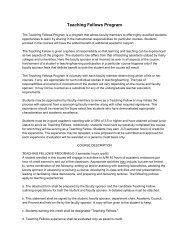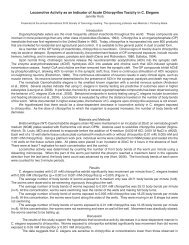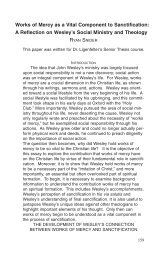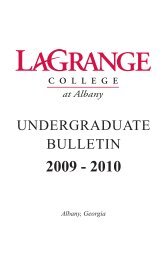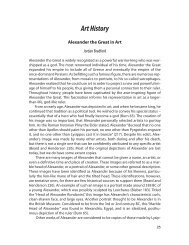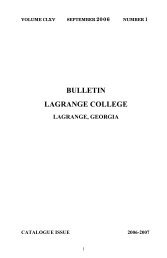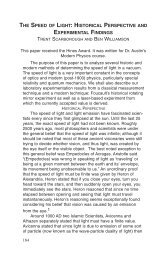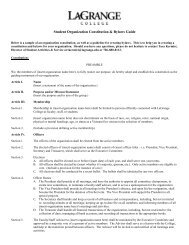Giovanni Arnolfini and His Bride
Giovanni Arnolfini and His Bride
Giovanni Arnolfini and His Bride
Create successful ePaper yourself
Turn your PDF publications into a flip-book with our unique Google optimized e-Paper software.
GIOVANNI ARNOLFINI AND HIS BRIDE:<br />
AHOPED-FOR PREGNANCY<br />
FLEMMING GARNER<br />
This paper was written for Dr. Joiner’s Renaissance Art <strong>His</strong>tory course.<br />
Jan van Eyck, <strong>Giovanni</strong> <strong>Arnolfini</strong> <strong>and</strong> <strong>His</strong> <strong>Bride</strong>, 1435.<br />
Jan van Eyck’s celebrated painting, <strong>Giovanni</strong> <strong>Arnolfini</strong> <strong>and</strong><br />
<strong>His</strong> <strong>Bride</strong>, has been given many titles over the years: The<br />
<strong>Arnolfini</strong> Portrait, The <strong>Arnolfini</strong> Wedding Portrait, <strong>and</strong> The<br />
<strong>Arnolfini</strong> Double Portrait are the most common of these. And<br />
along with the painting’s many titles has come a plethora of<br />
analyses <strong>and</strong> interpretations. Erwin Panofsky was among the<br />
first, giving what is now known as the classical analysis of the<br />
painting. Panofsky suggested meaning for images within the<br />
work, such as the signature of the artist, representing his witnessing<br />
of a marriage, making the painting in his words a “pictorial<br />
marriage certificate” (124). After Panofsky’s 1934 commentary,<br />
the painting again came under scrutiny in 1989 by the feminist<br />
critic Linda Seidel. According to Seidel, <strong>Giovanni</strong> <strong>Arnolfini</strong><br />
appeared to “have been marrying ‘up’” (60), alleging that in fact<br />
23
<strong>Giovanni</strong> <strong>Arnolfini</strong> <strong>and</strong> <strong>His</strong> <strong>Bride</strong>: A Hoped-For Pregnancy<br />
Giovanna <strong>Arnolfini</strong> had the money in the marriage. Each critic<br />
of The <strong>Arnolfini</strong> Portrait has given a new twist to the painting<br />
<strong>and</strong> to the meaning behind the two central figures. The varying<br />
interpretations notwithst<strong>and</strong>ing, the work has a fundamental<br />
focus in the painting on fertility <strong>and</strong> childbearing. This focus is<br />
clear in the numerous veiled symbols <strong>and</strong> in the painter’s allusion<br />
to a traditional Annunciation scene.<br />
The two figures in the painting have been firmly identified:<br />
<strong>Giovanni</strong> <strong>Arnolfini</strong>, a Lucchese cloth merchant, <strong>and</strong> Giovanna<br />
Cenami, the daughter of a fellow cloth merchant, also from<br />
Lucca in Italy. Theirs was a powerful political union of two influential<br />
Italian families living in Northern Europe. As <strong>Arnolfini</strong> continued<br />
with his career <strong>and</strong> became very wealthy, he began to<br />
work for the Medici Bank <strong>and</strong> then found himself immersed in<br />
the politics of Northern Europe. The hope of this union was to<br />
produce an heir who would continue in the cloth business, especially<br />
since <strong>Giovanni</strong> <strong>Arnolfini</strong> was often away for political reasons.<br />
During the 15 th century, moreover, women had specific<br />
responsibilities within the home, childbirth being the most important<br />
of these duties. The <strong>Arnolfini</strong> betrothal is one of many portraits<br />
created with the similar idea of presenting a newly-wed<br />
couple <strong>and</strong> then underscoring the hoped-for procreation.<br />
In the case of <strong>Arnolfini</strong> <strong>and</strong> his young bride, van Eyck has<br />
featured several veiled indications alluding to the prospect of<br />
fertility <strong>and</strong> conception. The 15 th century Northern community<br />
had high expectations for married women, especially for recently<br />
married brides, to conceive, preferably on the first night of the<br />
marriage. Because of the emphasis placed on the importance<br />
of having children <strong>and</strong> of forming a family, Northern women<br />
often surrounded themselves with tokens to induce fertility in<br />
hope for a successful pregnancy. Thus, Giovanna Cenami<br />
st<strong>and</strong>s on the right of the portrait by a beautiful red bed, which<br />
not only displays her status in the home but also her wifely duty<br />
of producing children. As a follower of the customs regarding<br />
childbearing, Cenami st<strong>and</strong>s barefoot beside the bed, her red<br />
slippers under a bench in the distance. As Craig Harbison<br />
observes, “The bare foot or accompanying shoe is an almost<br />
universal symbol of fecundity, [<strong>and</strong>] women especially must<br />
touch the earth to be fertile” (261). It was later that during the<br />
17 th century that artists displayed the removal of slippers as evidence<br />
of sexual passion. According to Harbison, “Northern<br />
24
Flemming Garner<br />
manuscripts <strong>and</strong> panels can also be seen reflecting these<br />
ancient customs” (261).<br />
It is particularly in the painting’s fruits that van Eyck symbolizes<br />
fertility. Just outside the window is a tree crowded with<br />
cherries, noted by Chevalier <strong>and</strong> Gheerbrant as “expressions of<br />
sexual desire” (412). And below on the chest sit oranges that<br />
Harbison considers directly “connected in numerous ways to<br />
marital <strong>and</strong> fertility rituals; especially when the newly-wed couple<br />
returns home to consummate their marriage, they are offered<br />
fruit <strong>and</strong> sweetmeats” (261-262). Fruit was also offered as a<br />
“cure to the morning sickness of pregnancy” (Harbison, 286).<br />
This image in particular shows the eagerness of the couple to<br />
have children, for the oranges are already there in anticipation<br />
of a successful impregnation. And “the fruit in Van Eyck’s work<br />
is no doubt meant to evoke fruitfulness . . .” (Harbison, 263).<br />
Yet another symbol refers to childbearing. Just above the couple’s<br />
h<strong>and</strong>s is a tiny statue of a monster, an attribute of Saint<br />
Margaret of Antioch. Margaret was a beautiful girl who declared<br />
her Christian faith to an admirer who took offense <strong>and</strong> locked<br />
her up in prison. It was while imprisoned that Margaret was tortured<br />
by the Devil in the form of a dragon; it is for this reason<br />
that Saint Margaret has the attribute of a monster. Margaret<br />
Carroll states that the little statue in van Eyck’s painting is a further<br />
attempt to ensure a successful conception, St. Margaret<br />
serving the couple as guardian to the fruitfulness of the womb<br />
<strong>and</strong> as the “patroness of childbirth” (107).<br />
A further reference to pregnancy can be seen in the stance<br />
of the pair. <strong>Arnolfini</strong> <strong>and</strong> his wife have been compared to a traditional<br />
Annunciation scene. This interpretation hinges upon the<br />
gesture of <strong>Arnolfini</strong>’s right h<strong>and</strong>. Harbison has observed that<br />
this gesture was “originally more rigid <strong>and</strong> upright, more oathlike<br />
in fact” (263). X-Ray analysis has revealed that the artist<br />
altered <strong>Arnolfini</strong>’s right h<strong>and</strong> to be more of a greeting than in<br />
earlier versions. This emendation shows that the husb<strong>and</strong> takes<br />
the place of the Angel Gabriel <strong>and</strong> his wife is then likened to the<br />
Virgin Mary, who will hopefully give birth to his child. In the<br />
words of Harbison, “It would seem an appropriate gesture during<br />
an Annunciation, acknowledging the “desired conception <strong>and</strong><br />
eventual birth of a child” (263). To underscore this interpretation,<br />
Harbison sees the presence of the Lord indicated in the<br />
“discarded slippers [on the left] <strong>and</strong> burning c<strong>and</strong>le, show[ing]<br />
the Trinity [<strong>and</strong>] answering a couple’s plea by sending down<br />
25
<strong>Giovanni</strong> <strong>Arnolfini</strong> <strong>and</strong> <strong>His</strong> <strong>Bride</strong>: A Hoped-For Pregnancy<br />
child from heaven” (267). The discarded slippers in this context<br />
represent the couple st<strong>and</strong>ing on holy ground, while the burning<br />
c<strong>and</strong>le reveals the Holy Ghost within the Trinity. A final presage<br />
of childbearing is seen in the fact that Giovanna <strong>Arnolfini</strong> lifts her<br />
green dress toward her waist, creating a protuberance akin to<br />
that of a pregnant woman. Edwin Hall writes that by “lifting her<br />
voluminous green gown [Giovanna is] thus quietly receptive to<br />
[her husb<strong>and</strong>’s] advances” (xix).<br />
These symbols—the fruit, the statuette of a monster, <strong>and</strong> the<br />
discarded slippers—together with the allusion to an<br />
Annunciation scene, underscore the <strong>Arnolfini</strong>s’ desire for a child.<br />
This interpretation strengthens the work Jan van Eyck created,<br />
because although <strong>Giovanni</strong> <strong>and</strong> Giovanna <strong>Arnolfini</strong> never conceived<br />
a child of their own; they nevertheless hope for one.<br />
This exact emotion apparent within the painting Jan van Eyck is<br />
able to capture; for the foundation of <strong>Giovanni</strong> <strong>Arnolfini</strong> <strong>and</strong> <strong>His</strong><br />
<strong>Bride</strong> is the couple’s assurance of a hoped-for pregnancy.<br />
26
Flemming Garner<br />
WORKS CITED<br />
Carroll, Margaret D. “‘In the Name of God <strong>and</strong> Profit’: Jan<br />
van Eyck’s <strong>Arnolfini</strong> Portrait.” Representations, 44<br />
(autumn 1993) 96-132. 26 Nov. 2007<br />
.<br />
Chevalier, Jean, <strong>and</strong> Alain Gheerbrant. Trans. John<br />
Buchanan-Brown. The Penguin Dictionary of Symbols.<br />
London: Penguin Books, 1996.<br />
Hall, Edwin. The <strong>Arnolfini</strong> Betrothal: Medieval Marriage <strong>and</strong><br />
the Enigma of van Eyck’s Double Portrait. Berkeley <strong>and</strong><br />
Los Angeles: University of California Press, 1994.<br />
Harbison, Craig. “Sexuality <strong>and</strong> Social St<strong>and</strong>ing in Jan van<br />
Eyck’s <strong>Arnolfini</strong> Portrait.” Renaissance Quarterly<br />
43.2(summer 1990), pp249-291. 26 Nov. 2007<br />
.<br />
Panofsky, Erwin. “Jan van Eyck’s <strong>Arnolfini</strong> Portrait.” The<br />
Burlington Magazine for Connisseures 64.372 (March<br />
1934) pp. 117-119+122-127. 24 Feb. 2008<br />
.<br />
Seidel, Linda. “Jan van Eyck’s <strong>Arnolfini</strong> Portrait: Business as<br />
Usual?” Critical Inquiry 16.1(autumn 1989) pp. 54-86. 24<br />
Feb 2008 .<br />
27




